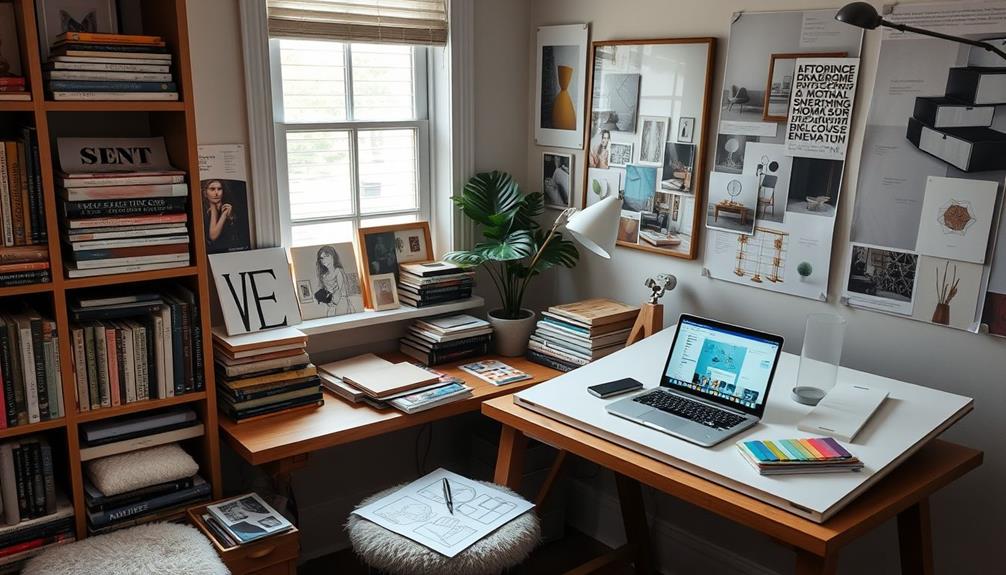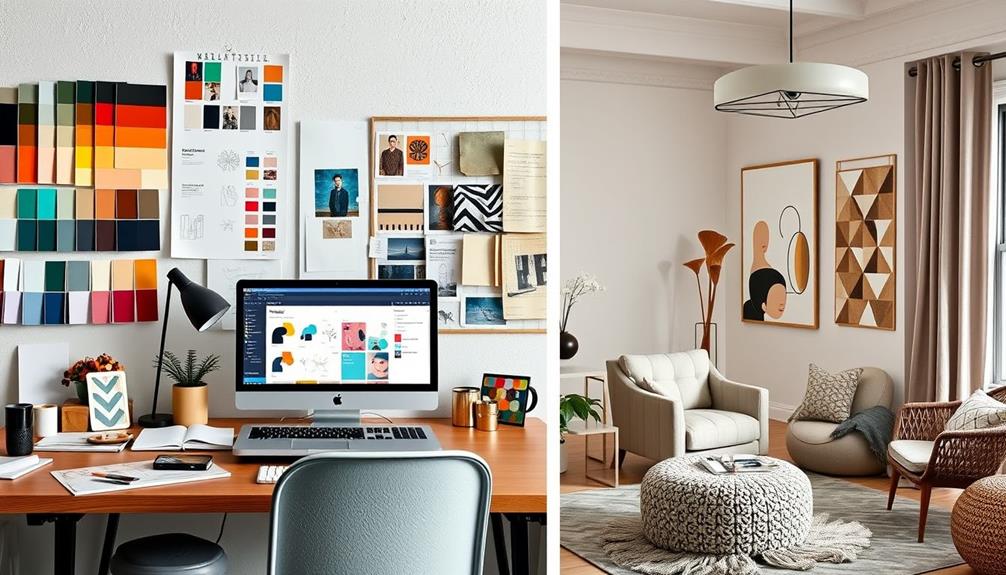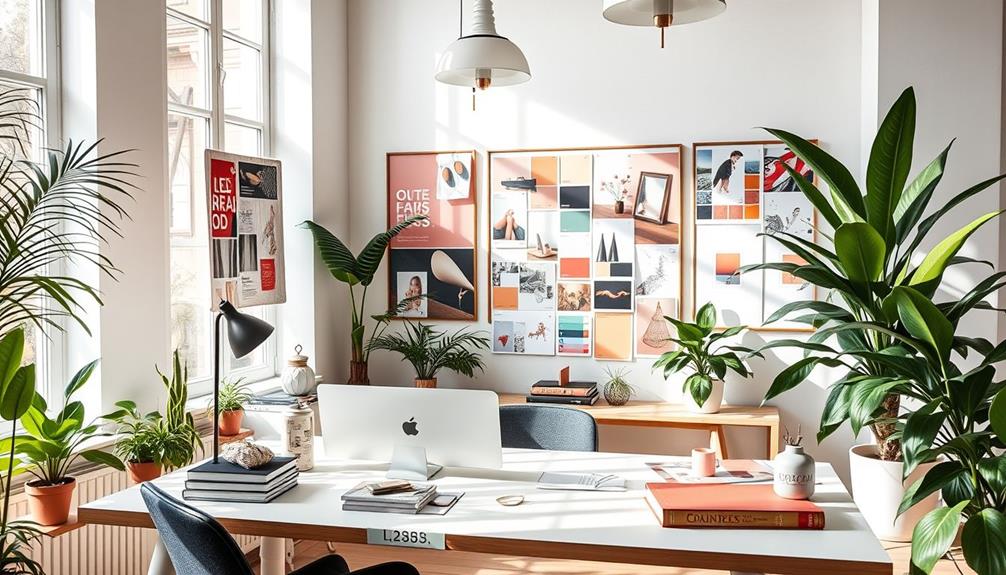To start your interior design career, first assess your skills and interests. Decide if you prefer residential or commercial spaces. Then, pursue education, like a degree in interior design, and consider gaining certification. It's vital to develop essential skills, including proficiency in design software. Build a professional network by attending industry events and joining associations. Create a business plan outlining your vision and target market. Finally, market your services effectively through a robust online presence. With these steps, you'll be on your way, and there's more to explore that can set you up for success in this exciting field. One pathway to consider is specializing in a particular style or type of design, such as sustainable or healthcare design. Another option is to gain experience through internships or apprenticeships with established designers. By continuously learning and honing your skills, you can carve out a successful interior design career pathway that aligns with your passions and goals.
Key Takeaways
- Assess your skills and interests to determine your focus on residential or commercial interior design.
- Pursue an accredited degree in interior design and obtain necessary certifications, like the NCIDQ exam.
- Develop essential design skills, including proficiency in design software and effective communication.
- Build a professional network by attending industry events and joining associations like ASID or IIDA.
- Create a business plan outlining your services, target market, and financial projections for a successful launch.
Assess Your Skills and Interests

Before diving into the world of interior design, it's vital to evaluate your skills and interests, as this will shape your journey ahead. Start by distinguishing between being a decorator and a designer; your passion, determination, and technical abilities will be fundamental in this evaluation.
Consider whether you prefer working in residential or commercial spaces, as this preference can guide your career paths and specialization.
As you explore potential career paths within the interior design industry, think about opportunities like working at a design firm, engaging in project management, or pursuing materials sales. Align these options with your interests and strengths.
Setting both short-term and long-term goals for your interior design career will provide direction, but remain flexible to adapt as you gain design experience and insights into the industry.
Additionally, engage in internships and other practical experiences to develop your skills. These hands-on opportunities are important for enriching your understanding of the field and will help you realize your aspirations as an interior design professional.
Pursue Education and Certification

Once you've assessed your skills and interests, pursuing education and certification becomes the next significant step in your interior design journey. A bachelor's degree in interior design typically takes four years, while an associate's degree offers a quicker two-year option. Both paths provide fundamental education and prepare you for a successful career in the field.
To maximize your opportunities, choose accredited programs recognized by the Council for Interior Design Accreditation (CIDA). This accreditation not only guarantees quality education but also aids when pursuing licensure and job opportunities. Your degree will include essential coursework such as art history, color theory, and space planning.
To become certified, you'll need to pass the National Council for Interior Design Qualification (NCIDQ) exam, which requires a degree and a specific number of work experience hours. Additionally, continuing education is imperative for maintaining your certification and staying updated on industry trends.
Here's a quick overview of your educational path:
| Degree Type | Duration | Key Requirements |
|---|---|---|
| Associate's Degree | 2 years | Basic design principles |
| Bachelor's Degree | 4 years | extensive design skills |
| NCIDQ Certification | Varies | Degree + work experience |
| Continuing Education | Ongoing | Workshops & seminars |
Develop Essential Design Skills

Developing essential design skills is essential for anyone looking to excel in interior design. Start by mastering drawing and perspective, as these fundamentals boost your ability to visualize and communicate design concepts effectively.
Next, get proficient in design software programs like AutoCAD, SketchUp, and Revit. These tools are critical for creating detailed floor plans and 3D renderings that clients expect from interior designers.
Strong organization skills and time management are equally important. They allow you to juggle multiple projects and meet deadlines efficiently, which is key when providing interior design services.
Don't underestimate the power of effective communication skills. You'll need to interact with clients, present your ideas, and collaborate with contractors and vendors to guarantee your design vision is accurately conveyed.
Lastly, embrace continuous learning. Attend workshops, take online courses, and participate in industry events to stay updated on trends and enhance your skill set.
Build Your Professional Network

To kickstart your interior design career, you need to build a strong professional network.
Attend industry events and join associations like ASID or IIDA to connect with designers and suppliers who can open doors for you.
These relationships won't only provide valuable insights but also lead to potential opportunities in the field.
Attend Industry Events
Attending industry events is one of the best ways to build your professional network in interior design. Trade shows and design expos are goldmines for connecting with fellow designers, suppliers, and potential clients within the interior design community. Engaging in local networking events and workshops enhances your relationships with architecture and design professionals, paving the way for future collaborations.
| Type of Event | Benefits |
|---|---|
| Trade Shows | Connect with suppliers and clients |
| Workshops | Learn skills and meet peers |
| Networking Events | Build relationships and find mentors |
Volunteering at these events showcases your commitment and can lead to invaluable mentorship opportunities with established designers. Additionally, don't forget to leverage your online presence; sharing your event experiences on social media platforms like LinkedIn and Instagram can greatly increase your visibility. This way, you not only expand your network but also position yourself as an engaged member of the interior design community. So, get out there, attend industry events, and watch your professional network flourish!
Join Professional Associations
Joining professional associations in interior design can greatly enhance your career. By becoming a member of organizations like the American Society of Interior Designers (ASID) or the International Interior Design Association (IIDA), you gain access to valuable resources, industry news, and networking opportunities.
These associations often provide educational workshops and webinars that keep you updated on the latest industry trends, essential for your interior design services.
Attending local chapter events and conferences allows you to meet potential clients, collaborators, and mentors, markedly expanding your professional network. Many associations also offer mentorship programs, connecting you with experienced professionals who can guide and support you in your career development.
This relationship can be invaluable as you navigate the complexities of the design world.
Moreover, being an active member of a professional association enhances your credibility and visibility in the industry. It makes it easier to attract clients and secure job opportunities, as potential clients view association membership as a mark of professionalism.
Create a Business Plan

Creating a solid business plan is vital for launching your interior design venture. Your plan should outline a detailed business description, highlighting your name, vision, goals, and target customers. Clearly define the interior design services you offer to attract potential clients.
Conduct thorough market research to identify demographics, analyze competitors, and discover your unique selling points. This will help you position your services effectively in the market. Additionally, establish realistic financial projections, including startup costs, ongoing expenses, revenue estimates, and a contingency fund to guarantee financial viability.
Your operational plan is also significant. Detail how you'll deliver services, manage projects, and communicate with clients. This will streamline your operations and enhance client satisfaction. Remember, regular reviews and updates of your business plan are essential to adapt to changing market conditions.
Here's a simple table to summarize key components of your business plan:
| Component | Description | Importance |
|---|---|---|
| Business Description | Name, vision, goals, and services offered | Establishes your brand |
| Market Research | Target demographics and competitors | Informs strategy |
| Financial Projections | Startup costs, expenses, and revenue estimates | Guarantees financial planning |
| Operational Plan | Service delivery and client communication | Streamlines operations |
| Regular Updates | Adapting to market changes | Sustains growth and relevance |
Market Your Interior Design Services

To effectively market your interior design services, establishing a strong online presence is essential. Start by creating a professional website that showcases your portfolio, services, and client testimonials. This helps attract potential clients effectively.
Utilize social media platforms like Instagram and Pinterest to visually engage your audience. Share design projects and tips to enhance your brand visibility and attract followers. Consider incorporating elements from popular design aesthetics, such as cottagecore home office, to appeal to your target market's desire for serene and cozy spaces.
Don't underestimate the power of networking events and trade shows. Attend these gatherings to build relationships within the industry, leading to referrals and new client opportunities.
Additionally, develop a content marketing strategy by blogging about design trends and offering free resources. This positions you as an expert and draws in potential clients through valuable information.
Implementing a referral program can also be a game-changer. By incentivizing satisfied clients to recommend your services, you'll effectively leverage word-of-mouth marketing to grow your client base.
Conclusion
Starting your interior design journey is like painting a masterpiece—each stroke of effort and creativity adds depth and vibrancy to your career. By evaluating your skills, pursuing education, and building a network, you're setting a solid foundation for success. Remember, a well-crafted business plan and effective marketing will help your vision flourish. So, embrace the challenge, trust your instincts, and watch as your passion transforms spaces and lives, one design at a time.







